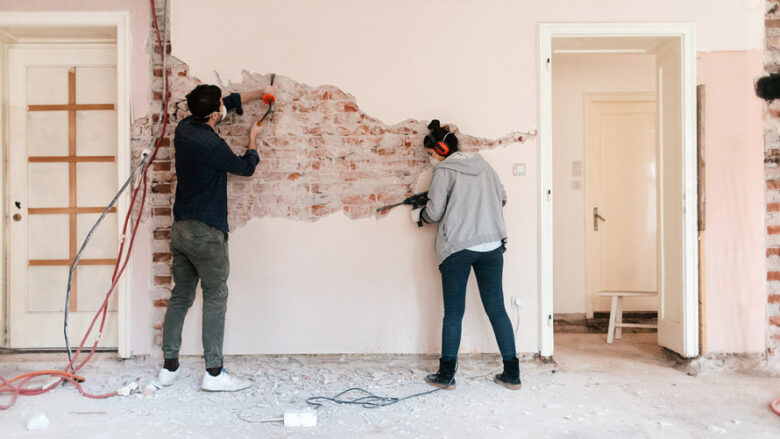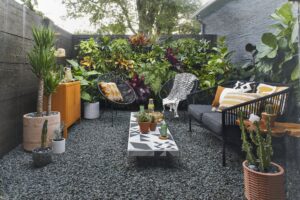Upgrading your home doesn’t have to require expensive equipment or an enormous budget; many DIY projects can make a significant difference in its appearance and overall value. Installing new door handles can be an inexpensive DIY project that will drastically change the appearance of your entire home. Other affordable DIY projects include framing a bathroom mirror and adding storage shelves.
1. Paint Your Walls
Painting walls is one of the easiest and most impactful ways to change a room’s style. Choose brighter hues to open up small spaces or darker tones for an intimate ambiance. Before painting your walls, carefully sand them down and fill any cracks or small holes with paintable caulking to get ready. While this step may not be exciting, it is vital in creating an outstanding result.
Planting greenery in your yard is another effective way to add curb appeal and value to your home. Just make sure that the plants used are perennials rather than annuals, which only last one year at best.
2. Install a Kitchen Faucet
One of the most vital kitchen updates you can make is purchasing a new faucet. Choose one that complements your aesthetic and ensure it will fit with your sink configuration before making your purchase. Doing it yourself doesn’t require professional plumbing help to install a new faucet; just shut off the water supply valves and use an adjustable wrench to disconnect hoses.
Replace the old faucet and add a new one for an immediate upgrade, while also strengthening your DIY skills and toolset before taking on larger renovation projects. This project can also serve as a great confidence builder when taking on larger-scale renovations later.
3. Install a Ceiling Fan
Upgrading your home doesn’t need to be a costly renovation or require contractors; simple DIY projects can bring about lasting changes that make an impactful statement about who lives there.
Installing a ceiling fan should be relatively easy if your ceiling already contains an electrical box for it (the wiring must match). But it can become more challenging if neither exists, or if you want to replace an existing fixture that was mounted directly to the ceiling. Always switch off power at the breaker for the room you are working in and use a voltage tester to make sure no wires are live. Clear away furniture and any items that could obstruct your work as well.
4. Install a Backsplash
Installing a backsplash in the kitchen is an efficient, affordable way to refresh and add value. Before beginning, it is important to turn off power at the breaker box and use a circuit tester to verify that all areas are completely dry before clearing out space with appliances, switches, and cabinets removed to prepare for tiling.
Select tiles to complement or coordinate with your countertop and cabinetry, and apply thin-set mortar using a notched trowel. Leave an expansion gap between countertops and cabinets, as well as finishing touches like Schluter strips, for an unblemished, finished look.
5. Install a Tile Floor
Tiling can add an instantaneous upgrade to any room in your home, and it’s simple enough for DIYers to complete themselves. But for optimal results, proper planning must take place along with special products and tools being utilized for installation.
Before beginning work on the floor, make sure that it is covered with cement backer board to create a stable surface that does not fluctuate in height with humidity levels. Make sure that the board is flat and centered to avoid what’s known as lippage. As soon as you’re ready to lay tile, start by drawing one layout line (from wall A to wall B). Measure and adjust until both walls A and B measure exactly equal in measurement.
6. Install a Kitchen Sink
If your sink has seen better days, updating it is an easy DIY project that can add significant value to your home. While more experienced DIY enthusiasts might find this undertaking more manageable, beginners can still complete this project successfully with proper planning and guidance.
Before beginning this project, ensure the water supply is turned off to avoid costly water damage. To do this effectively, turn off both hot and cold-water valves under your sink. Before buying a sink, ensure it fits with your existing countertop dimensions and drain location (if applicable). Place it upside-down into its hole on your countertop surface and ensure a proper fit before making any adjustments if necessary.
7. Install a Window Treatment
DIY projects can transform your home without breaking the bank, such as installing new light fixtures or creating storage space by adding floating shelves. Most DIY projects don’t present too many difficulties to novice DIYers as long as you follow instructions carefully.
Add trim to your walls for a customized look with affordable off-the-rack moldings available at home improvement stores. Add curb appeal by landscaping your yard. Plant colorful flowers and plants throughout the year, create a garden bed or window box, and attract butterflies and birds with these features.
8. Install a Shelving System
Wall-mounted shelves can add extra storage space or be used to display a collection of clocks—and add to your decor at the same time. There’s something suitable for every style and material available, so finding one to complement the aesthetic of your home shouldn’t be hard!
To ensure safety, always fasten standards and brackets securely to wall studs using a stud finder and marking them with a pencil. These DIY projects will elevate the style of your home! Grab a toolkit from Rent-A-Center near you and give these easy upgrades a try for yourself!
9. Install New Flooring
Installing new flooring can add an entirely new dimension to your home and increase its value, too. Hardwood floors are an ideal way to transform any room. Not only are they more stylish than carpet, they’re easier to keep clean too. Before installing hardwood, ensure the floor is level by using a level to identify high and low areas on the floor, then using a hammer and chisel to smooth away bumps or fill low spots with material.
Once the floor is completed, install baseboards and transitions. Leave room for floor vents and doorways when placing transitions. Also, allow three to seven days for your hardwood to adjust to its room conditions before being installed, as this will help avoid it shifting once in place.



